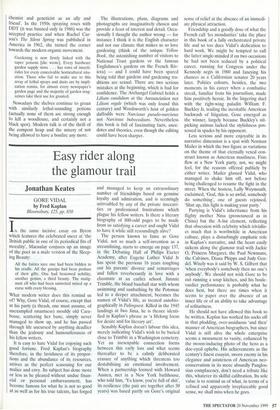Il faut
cultiver notre jardin
Rosanna James
THE PURSUIT OF PARADISE by Jane Brown HarperCollins, £19.99, pp. 377
Ienjoy riding slowly through the villages near here, when the added height gives extra views over garden hedges. From the choice of plants and paths, tidiness and neglect, I feel I know as much about the people who live there as a photograph or voice would tell. Next to our flat in New- castle are some fairly expensive modern town houses where the entire garden usu- ally changes each time the house changes hands — planted in one day with a mass of
container-grown shrubs, destined to become far too big far too quickly, although they arrived in perfect height order. Current television gardening with a demented team and a stopwatch has a lot to answer for. It belittles and denies all the true pleasure of gardening: watching things grow and waiting with excitement for the next season. These are up-to-date glimpses of social life behind the garden fence.
It is the greatest of good fortune to like gardening, and Jane Brown's title is invit- ing and apt. This is a serious, densely factu- al book (there are 50 pages of notes and index) and hardly a name or place in the gardening world is left out. After reading the lengthy introduction my head was swirling from Mr McGregor's hoe to the
classical Greeks, and from the cult flower of the moment (the snowdrop) to the draw- ings of Knyff and Kip. I feared that Tart d'ennuyer c'est de tout dim.'
Jane Brown writes at length about chil- dren and gardens. She quotes Robert Louis Stevenson and his Child's Garden of Verses,
'where the familiar garden becomes a world of adventure', and movingly
describes the bedridden Colin in Frances Hodgson Burnett's The Secret Garden as he gradually gets better and stands on his own feet, and where the children actually gar- dened. She explains how fortunate it can be for a child to own a garden (although chil- dren have worked in gardens as cheap labour) and writes of a host of childhood contacts with gardening, from growing the seeds of mustard and cress on a wet flannel to the excellent plans for primary and sec- ondary school gardens in the 1960s. When I was a teacher at a school near Newcastle, I could watch the gardening lessons from my classroom. Although the children who were already good at maths and English set to with their trowels and packets of seeds, the less interested ones were very naughty and did little more than turn the hose-pipes on themselves and their teacher. Brown explains the practical difficulties of teach- ing a large class in even a 'semblance of order' inside a greenhouse or beside some seemingly unpromising squares of earth.
I loved the story of the six-year-old Will Ingwersen (of the award-winning nursery in
Sussex) taking the sickly seedlings of Gen-
tiana vents off the rubbish dump where his father had thrown them, nursing them back to life, and then selling them back to his father. As children grow up their associa- tion with gardens is often more to do with games and sport than growing plants. Jane Brown tells entertaining tales of tennis and croquet; she dips into Alice's adventures with the Red Queen and the 'brilliant, gen- tle and yet repressed mind of Lewis Car- roll'; she writes of lawns and pools and patios, of children's swings and archery.
'Pesticide' was a new word in 1943 and came as a godsend (so it was thought) fol-
lowing years of individual struggles against garden ills. The 1940s reader of the Gar- deners' Chronicle 'readily accepted the chemist and geneticist as an ally and friend'. In the 1950s spraying roses with DDT (it was banned only in 1986) was the accepted practice and when Rachel Car- son's The Silent Spring was published in America in 1962, she turned the corner towards the modern organic movement.
Gardening is now firmly linked with the super poisons [she wrote]. Every hardware garden supply store . .. has rows of insecti- cides for every conceivable horticultural situ- ation. Those who fail to make use to this array of lethal sprays and dusts are by impli- cation remiss, for almost every newspaper's garden page and the majority of garden mag- azines take their use for granted.
Nowadays the shelves continue to groan with similarly lethal-sounding potions (actually none of them are strong enough to kill a woodlouse, and certainly not a black spot). Modern talk is of the thrill of the compost heap and the misery of not being allowed to have a bonfire any more.
The illustrations, plans, diagrams and photographs are imaginatively chosen and provide a feast of interest and detail. Occa- sionally I thought the author wrong — for instance I think it is the English character and not our climate that makes us so love gardening (think of the unique Yellow Book, the astonishing number of visitors to National Trust gardens or the famous Englishmen's gardens on the French Riv- iera) — and I could have been spared being told that gardens and gardening tra- ditions are sexual. There are two serious mistakes at the beginning, which is bad for confidence. The Archangel Gabriel holds a Lilium candidum at the Annunciation not Lilium regale (which was only found this century) and Wordsworth's host of golden daffodils were Narcissus pseudo-narcissus not Narcissus bubocodium. Nevertheless this book is full of fascinating facts, anec- dotes and theories, even though the editing could have been sharper.



























































































 Previous page
Previous page